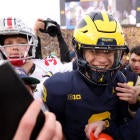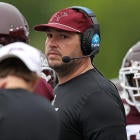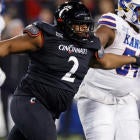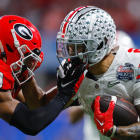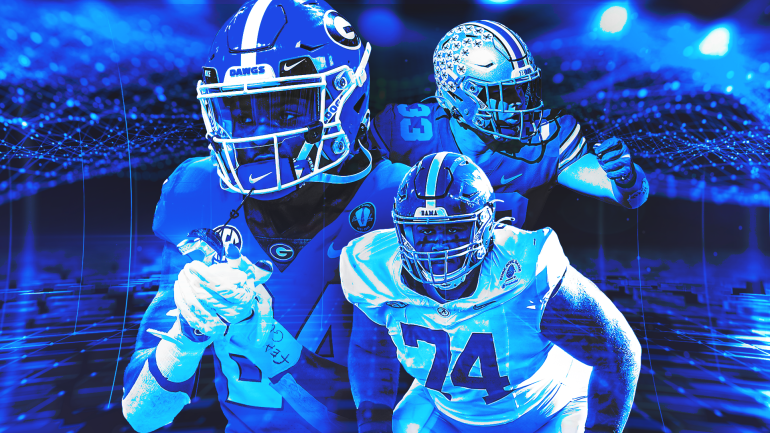
Which schools have recruited well enough to emerge as national champion in the 2024 season? To determine this, it's essential to understand the level of talent required to clinch college football's biggest prize, according to recent standards.
I set out to answer this question over a decade ago by creating the Blue-Chip Ratio.
Since its inception in 2013, the Blue-Chip Ratio has been referenced by all major broadcast networks and closely monitored by head coaches and administrators. It is also being featured in the EA Sports College Football video game revival. Although it's not the most complex calculation, it's an excellent method for identifying the top 10% of teams that realistically have a shot at winning the title.
In simple terms: To win the national championship, college football teams need to sign more four- and five-star recruits (AKA "Blue Chips") than two- and three-star players over the previous four recruiting classes.
This has been consistently true since the advent of modern internet recruiting rankings. But, this is not to say that the Blue-Chip Ratio guarantees a national title, or even competing for one.
The requirement to stack talent on top of talent makes sense when considering the violent nature of football. Even teams which stay relatively healthy need depth to survive the season. Teams who sign elite class after elite class have greater competition in practice and greater quality of depth.
Recruiting rankings are not perfect, but they are damn good, especially in the aggregate. Four- and five-star recruits are about 10 times more likely to be drafted in the first round of the NFL Draft than their two- and three-star counterparts. And five-stars are about 33 times more likely to be All-Americans as two-stars. For every two-star who becomes a big success, there are multiples who will be going pro in something other than sports. And they are getting better annually due to advancements in technology and data.
That is not to say that development does not matter. It certainly does. But nobody wins a national title by player development in lieu of elite recruiting. Plenty of coaches who are regarded as elite have never sniffed winning it all because they can't accumulate enough talent. On the other hand, there are examples of coaches who are not regarded as premier head men who have won it all thanks to elite recruits. Not to lump them into the same category, but nobody ever accused Gene Chizik, Les Miles, Mack Brown or Ed Orgeron of being tactical masterminds.
How has this stat performed in the past?
- 2023: Michigan won it all with a 54% mark.
- 2022: Georgia took home the title in dominant fashion with a 77% ratio.
- 2021: Georgia had an 80% BCR and won it all, beating the No. 1 BCR team, Alabama, in the title game. Three of the four CFP teams were BCR teams; Cincinnati was the first party crasher since 2017.
- 2020: Alabama had an 83% BCR and won it all. All four CFP teams were BCR schools.
- 2019: LSU won it with a 64% BCR. All four CFP teams were BCR schools.
- 2018: Clemson took it home with a 68% mark. All four CFP teams were BCR schools.
- 2017: Alabama won it all with an incredible 80% mark.
- 2016: Clemson took home the title after signing 52% blue chips in the 2013-16 classes.
- 2015: Alabama had a 77% mark.
- 2014: Ohio State won the title with a 68%.
- 2013: Florida State was at 53%.
- 2012: Alabama was at 71%.
- 2011: 'Bama won the first of its back-to-back titles ... also with a 71% mark.
The Blue-Chip Ratio is not ...
A requirement to make the College Football Playoff. While related, making the College Football Playoff and winning it are two drastically different accomplishments in terms of difficulty. Schedule strength plays a much bigger role in the former. Plenty of teams outside the BCR threshold made the four-team College Football Playoff (typically getting crushed, by the way), and many more will make the new 12-team field.
A substitute for player development, culture or coaching. All of those elements matter and are necessary to win the national title. The BCR is simply the minimum historical standard of recruiting necessary to win it all.
To be used to pick games. It is not an effective predictive measure in single-game settings
What about transfers?
Transfers are not included in the main Blue-Chip Ratio calculation. There are a few reasons for this.
Through four years of heavy transfer portal activity, national titles are not being won primarily through the portal. Michigan did have several in 2023, but most of the team was developed out of high school. Georgia did not take a single scholarship transfer in 2022 and had little reliance on it in 2021. The best teams recruit high school very well and then look to fill holes or upgrade in spots via the portal. Teams loading up on transfers are frequently coaches looking for a jumpstart to a new tenure, or, on the other end, looking for a fix to save their jobs.
Not always, though.
But with each passing year, transfers are becoming more ubiquitous within the sport of college football thanks to the removal of the year-in-residence requirement, immediate eligibility and now unlimited transfers. There were more than 2,000 scholarship transfers this offseason alone.
247Sports has recognized and reacted to the explosion of transfers with the most comprehensive transfer ratings in the industry. Multiple staff members who have worked for college football personnel offices play key roles in these ratings. And, important to me if I was going to include transfers in the Blue-Chip Ratio, the proportion of blue-chip ratings given out relative to two- or three-star ratings is somewhat consistent with the grades assigned to high school and JUCO recruits.
But what I do not know is how those grades will look when evaluated during the NFL Draft process. I have that data for years and years of high school recruits and know that high-school recruiting data is predictive in a way that transfer ratings have not yet shown to be.
Since the BCR is a historical standard, I will continue to monitor the data and make a determination as to how it is incorporated into these calculations. I will also provide info of how the BCR looks if transfers were incorporated later in this story, and the results might surprise you.
Enough talk, show me the list
| School | BCR |
|---|---|
Ohio State | 90% |
Alabama | 88% |
Georgia | 80% |
Texas A&M | 79% |
Oregon | 76% |
Oklahoma | 73% |
Texas | 72% |
LSU | 70% |
Notre Dame | 67% |
Clemson | 64% |
Florida | 63% |
Miami | 61% |
Penn State | 61% |
USC | 59% |
Michigan | 56% |
Auburn | 53% |
I expect Florida State (49%) to join the list next year. No other team is even two foreseeable recruiting classes away from crashing the party.
SEC, Big Ten superiority
Conference superiority, a common talking point in college football circles, shows up here. The SEC and Big Ten claim 13 of the 16 teams. The SEC leads the way with eight teams ... more than the Big Ten and ACC combined.
The Big 12 has zero teams who are realistically even three recruiting cycles away from having a team on this list. For national title-winning purposes, the ACC is closer to the Big Ten than it is to the Big 12, at least until the outcome of ongoing lawsuits against the league from Florida State and Clemson are resolved.
In terms of teams outside the Big Ten and SEC, the only programs showing up on this list with any consistency are Clemson, Florida State, Miami and Notre Dame.
Who could bust the Blue-Chip Ratio?
I don't actually think that the Blue-Chip Ratio will hold forever. Standards are made to be broken.
At some point, a team with maybe a high 40s number, a transcendent QB and great injury luck could bust this. It's probably bound to happen. The closest was the Clemson team Alabama beat when Nick Saban successfully called for an onside kick to turn the tide of the CFP National Championship in 2015.
Florida State would have been an interesting case in 2023 had QB Jordan Travis not been injured, though doubters would point out that Florida State was 7th in popular power ratings like SP+ the week before Travis went down.
By the "narrowly misses the minimum threshold + transcendent QB" standard, Tennessee (46%) is the most obvious candidate to bust the ratio in 2024. QB Nico Iamaleava has special physical talent, and if Tennessee can stay healthy at offensive line and in the secondary, perhaps the Volunteers could pull off something special.
It is worth noting that while access to the playoff has never been greater than it is under the new 12-team format, the format also requires teams to win three or even four difficult games to secure the national title. That could make it more difficult for longshots to shock the country.
What would the Blue-Chip Ratio look like with transfers?
I am glad you asked because this is something I have put a lot of thought into. Due to the lack of sample set, the predictive nature of transfer ratings is an unknown.
What does seem to track is that almost all teams see their BCR go down when transfers are included. That seems logically consistent with the idea that while some transfers are special players, the majority of them, even those taken by good schools, are being used to fill roster holes. Most of the sport's truly elite players are recruited out of high school and retained by the school with which they signed.
But some programs have attacked the portal in huge numbers. As mentioned above, Florida State managed to climb to 7th in SP+ (and higher in the polls) before Travis got hurt. And Ole Miss, a team even more reliant on transfers (almost 50 in the last two cycles), finished 12th in SP+.
| School | BCR with transfers |
|---|---|
Ohio State | 86% |
Alabama | 82% |
Georgia | 77% |
Oregon | 71% |
Texas | 70% |
LSU | 66% |
Clemson | 64% |
Oklahoma | 63% |
Notre Dame | 63% |
Texas A&M | 63% |
Florida | 58% |
Penn State | 57% |
Miami | 56% |
USC | 54% |
Michigan | 54% |
Florida State | 53% |
Florida State is the largest positive mover, by far, when incorporating transfer ratings. The largest fallers are Texas A&M and Oklahoma, who took 40 and 30 transfers in the last two years, respectively, most of which were not high-end players.
Ole Miss is a fascinating case. The Rebels are sixth in the national title odds after making some significant additions via the portal to a team that was already playing at around a top-10 level. Still, over this cycle and the last, Ole Miss has signed 47 transfer portal players and just 16 were rated as blue-chip prospects. Suffice to say, folding them in does not move them closer to the Blue-Chip Ratio club.
Consider that winning the national title takes a lot of top-end talent. The last five national champions have averaged more than six first-round picks in the successive two drafts, plus many more top-100 picks. Does Ole Miss have that level of talent? Last year in the regular season, the Rebels had single-score wins against LSU, Texas A&M, Auburn, and Arkansas, while losing by two touchdowns to Alabama and five touchdowns to Georgia. Can their transfers and veteran experience make up that gap? Who knows. College football is at a time of great upheaval.









